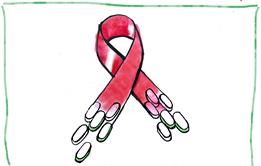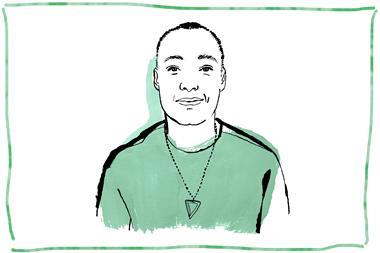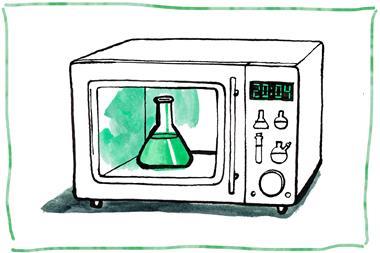From one big pill that only prolonged lives a few months, through the 20 pills a day years to modern combination therapies, treating HIV is a science success story
What were the early treatments for people infected with HIV?
Our medicine cabinets are spartan in antivirals and initially there was no treatment available. Around 90% of those infected had just five to 10 years’ life expectancy.
The very first therapy approved was azidothymidine (AZT) in 1987. This compound had first been made in 1964 as an anti-cancer drug. The company Burroughs Wellcome had screened many compounds against HIV-infected animal cells in a dish, before deciding to test AZT in patient trials. ‘When it got into the clinic, it seemed like a miracle,’ says Dennis Liotta, a chemist at Emory University in Atlanta, US, who made major contributions to HIV drug discovery. ‘Patients got much better, but only for a few months.’ It prolonged the lives of patients for six to 18 months.
As HIV is an RNA virus, on entering a human cell it must convert this RNA into double-stranded DNA. This is the job of reverse transcriptase (RT), which became a hot target for early HIV drugs. AZT became the first approved drug to gum up this crucial enzyme. Other nucleoside reverse transcriptase inhibitors (NRTI) became available in 1991 (didanosine), 1992 (zalcitabine) and 1994 (stavudine). Unfortunately, the RT enzyme is error prone, and the virus quite quickly hits on mutants that can escape these drugs. The result: patients quickly relapsed.

When did drug developers move beyond targeting one enzyme?
It wasn’t until the mid-1990s. In 1995, the first protease inhibitor was approved – saquinavir. This binds to the catalytic site of the protease enzyme and stops it from cleaving the long polyprotein chains into individual viral proteins, which is needed for the virus particle to mature. Patients were first prescribed combination therapies in 1996, then called highly active antiretroviral therapies (HAART), made up of RT inhibitors and protease inhibitors. That same year, two more protease inhibitors were approved by the US Food and Drug Administration (indinavir and ritonavir), with two more in 1997. HAART greatly reduced opportunistic infections and deaths in Aids patients.
The one-two punch of RT and protease blockers was also far better at preventing resistant viruses emerging. Yet the strategy was burdened with a major downside. Initially, grams per day of drugs had to be taken. ‘That became a compliance nightmare,’ says Liotta. If someone failed to take their drugs, a sea of troubles headed their way when therapeutic levels dipped. ‘As soon as they’re sub-therapeutic, resistant mutants could emerge, and your meds stopped working.’ That put huge pressure on patients to swallow prodigious quantities of pills.
In 1997, the combination therapy Combivir was approved by the FDA. This consisted of an NRTI (lamivudine) and AZT.
What other major drug discoveries made a difference to patients with HIV infection?
The first batch of drugs to target the RT enzyme, such as AZT, worked by getting competitors to the natural building blocks of viral genomes into infected cells. This clogged the enzyme that transcribed viral RNA to viral DNA. Then, in the 1990s, compounds were developed to lock onto RT in such a way as to distort the enzyme’s shape and inhibit its activities.
The first of these non-nucleoside reverse transcriptase inhibitors (NNRTIs) to be approved was nevirapine in 1996, followed by delavirdine in 1997 and then efavirenz in 1998. The RT enzyme is shaped like a closed fist, with movable fingers and an overlapping thumb. The thumb lifts up and fingers fold down to hold the piece of nucleic acid during a reaction. Despite being chemically varied, all NNRTI compounds hit a hydrophobic spot beside the active site, close to the flexible thumb, and restrict movement of the enzyme. DNA synthesis then slows. ‘They are like a grain of sand getting into the hinge, stopping it from closing down,’ says Rafick-Pierre Sekaly, HIV researcher at Emory University.
How – and when – did the drugs become more practical and effective for patients?
‘At the beginning of the 2000s patients had to take up to 20 pills a day,’ says Sekaly. This was especially onerous considering the possible risk of resistant mutants arising if drugs were not taken as prescribed. Yet progress was made in hitting the virus in multiple ways. Atripla, for example, was approved in 2006 and contained three inhibitors for reverse transcriptase (efavirenz, emtricitabine and tenofovir disoproxil fumarate). ‘That was a game-changer, because we went from 15 or 20 pills in the mid-90s to taking one pill three times a day,’ says Liotta.
Integrase inhibitors simplified regimes to the extent that one pill a day became feasible
Then newer drugs landed with a bang. ‘The breakthrough came when Merck & Co in the US came up with the first integrase inhibitor, raltegravir, and that caused a tsunami,’ says Sekaly. Integrase is a viral enzyme that binds to viral DNA and helps plug it into the DNA of the host cell. First approved was raltegravir in 2007, followed by dolutegravir in 2013. Meanwhile, drugs came onto the market that were safer than predecessors, such as the NRTI drug emtricitabine, an analogue of the nucleotide cytosine that was introduced in 2003.
In the late 2000s, the situation improved again. Integrase inhibitors were included with the existing drug classes. This simplified regimes to the extent that one pill a day became feasible. In 2018 alone, the National Institutes of Health timeline lists seven fixed dose combination (FDC) regimens as receiving approval, such as Biktarvy, Delstrigo and Symtuza. None of the drug combinations can cure a person of an HIV infection, however.
Why can’t we eradicate HIV completely from the body using all these new drugs?
Antivirals are effective at knocking down replication in HIV-1 and reducing virus numbers, but they cannot cure. As soon as someone stops taking treatment, the virus rebounds. Why? Once inside the cell, the reverse transcriptase enzyme flips viral RNA into DNA and incorporates itself into the patient’s own DNA. The therapies cannot get at this DNA. Some of these proviruses stay asleep in the lymph nodes, small structures that filter foreign substances and contain immune cells, including infected CD4 T cells in HIV patients. The immune system cannot see them, as proviruses do not express genes. To wipe out hidden proviruses, they need to be awoken and then hit with antivirals. That is a steep climb. ‘The problem with HIV is that you need to ensure that you get rid of every infected cell,’ says Sekaly. Other hideouts for the virus are in the brain, spinal fluid and testes.
How are scientists trying to do it?
A few options are being tried. One approach is to use Crispr gene editing to target those sequences of viral DNA. This has been done for cells infected with HIV-1 in a lab. Another strategy is edit a patient’s own cells. The first step is to extract their T cells and edit out the surface glycoproteins that HIV-1 uses to dock onto its cellular victim, thereby protecting them against the virus. This is akin to chimeric antigen receptor T-cell (CAR-T) therapy for cancer patients.
A study at UC Davis (announced in 2022) aimed to insert a gene into T cells that would cause them to go after infected cells. Within months, results are expected from another trial (Trailblazer) that infused modified T cells back into patients infected with HIV-1. ‘It costs around $30,000 per patient right now, which is a lot cheaper than CAR-T cells for cancer, but the goal is to engineer the cells so that they are more durable,’ says Sekaly. ‘This would enable us to use way less cells and that could reduce costs ten fold.’
What are the standard treatments for HIV today?
Most people can get the virus under control with therapy within six months, according to the Centers for Disease Control and Prevention in the US. Successful treatment can render HIV undetectable in blood. Biktarvy from Gilead is popular, allowing people with HIV-1 to swallow a single pill, once a day. This contains three antivirals: emtricitabine; the integrase inhibitor bictegravir; and tenofovir alafenamide (a nucleoside reverse transcriptase inhibitor). It works by lowering the amount of HIV in the blood and can help delay problems, according to the Mayo Clinic.
The two big trends are to have dosing regimens that are once a week or once a month
Another commonly prescribed combination contains tenofovir disoproxil, lamivudine and dolutegravir (TLD). This generic medicine is not available in many high-income countries, because dolutegravir (an integrase inhibitor) is under patent.
There are also now injectable drug combinations such as cabotegravir (an integrase inhibitor) and rilpivirine (a non-nucleoside reverse transcriptase inhibitor), an intramuscular injection that can be given once monthly or every two months. It was reportedlast year that the generic TLD combination could be given as a long-lasting injectable. ‘The two big trends are to have dosing regiments that are once a week or once a month, for oral agents, and the other is the opportunity for a cure,’ says Liotta.
When’s the cure for HIV coming?
Three people have been cured of HIV after stem cell transplants, while there are a few cases of ‘exceptional HIV control’ in untreated people. Several cases of control after a patient stopped treatment have also been reported, according to the UK charity Aidsmap. The big defense HIV virus has against our immune system and our drugs is its ability to slip into the DNA of our cells and go silent – so-called proviral latency. So long as someone has HIV virus hunkered down in stealth mode, they are not cured. There are also some places in the body where the virus persists despite treatment. ‘Once it is free to replicate somewhere, the virus can leak out and spread through the lymphatic system,’ says Liotta.
Nonetheless, the field is optimistic. Organisations such as the National Institutes of Health are unabashed in talking about a possible cure for HIV. And different groups walk different paths in their quest to cure HIV. ‘We’ve been trying for a cure for four decades, but some hopeful advances have emerged,’ says Liotta. Sekaly is also optimistic: ‘I don’t think we will have a cure in the next five years, but we are heading in the right direction, and we’ve opened up to more than one concept,’ he says.
Anthony King is a science writer based in Dublin, Ireland
Article updated 08 May 2024 to clarify the effect of Biktarvy

How HIV drugs have changed over the decades

From one big pill that only prolonged lives a few months, through the 20 pills a day years to modern combination therapies, treating HIV is a science success story
 Currently
reading
Currently
reading
How HIV drugs have changed over the decades
- 2



















No comments yet